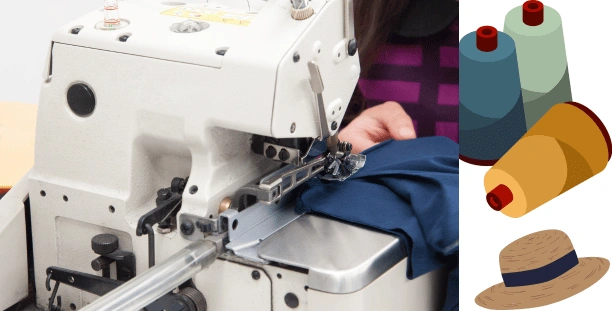Industrial Engineering (IE) in the Apparel Industry
Industrial Engineering (IE) in the Apparel Industry
Industrial Engineering is manufacturing engineering to increase productivity and quality. The horizon of Here I have written about Industrial Engineering (IE) in the Apparel industry, job scope, job description, and basic IE work of the apparel industry.
Industrial Engineering in the Apparel industry
Apparel manufacturing factories are facing global competition for cost-saving, productivity, and quality improvement. Industrial Engineering is dealing with these factors to reach the highest level of productivity and quality with minimum waste. So an industrial engineer has a wonderful opportunity to contribute to the apparel manufacturing sector by implementing all engineering tools for the growth of this industry.
IE team works in cutting, sewing, and finishing to reduce manpower and WIP, setting line Layout (operation breakdown) increase work efficiency and productivity, Demand forecasting, developing a new design, Develop Layout, Working with different quality tools, Bend product and seasoning development, Efficiency, Wages and earning calculation, CNC machine operation, Scheduling, Capacity analysis, Line balancing, Kaizen, Kanban, Production planning, Calculate NPT, Bottleneck removing, etc.. They analyze CM, SMV, costing, consumption, profit- Loss. Good IE teams make a good efficient factory. They also follow up daily production targets and production achievements being responsible for production, working in the sewing line if there is any bottleneck.
Generally, Textile engineer, IPE engineer, and other academic background work in the Garments IE department, career growth is very quick here. After merchandising, all textile graduates go for IE jobs in a Garments factory. Starting a career in IE department is not very easy, there is a challenge too and pressure to fill up the production target of assigned sewing lines. After reaching one stage, your job will give you comfort to be followed up work sitting in own desk. This is the era of the 4th industrial revolution where people go innovative ways to increase the growth of productivity.
The importance of industrial engineering in the Garments industry
When garment manufacturers faced a threat of global competition, other manufacturers produced products at a lower cost; the garments industry started to set industrial engineering to produce more goods at a lower cost. Industrial engineering works to produce maximum output by limited minimum resources and every action taken to calculate what adds value to the product.
IE jobs in the Garments industry:
My career started in the IE department as an IE officer and grew faster than any other department in the apparel manufacturing industry. There are many jobs out there in the IE department. In recent times garment industries have hired many employees to work for engineering development in their facilities. Job designations are IE officer, executive, senior executive, assistant manager, manager, head of IE, AGM/DGM/GM
Basic knowledge of doing IE job in Garments
Basic knowledge is about Industrial engineering such as efficiency, production, productivity, overall efficiency, on standard efficiency. Major KPIs such as man-to-machine ratio, cut-to-ship ratio, order-to-ship ratio, on-time delivery percentage, average style changeover time, DHU, quality to the production, NPT, the major area of NPT. Skill matrix, what are the criteria of operator grading? Thread consumption, elastic, lace consumption knowledge.

Identify bottlenecks and eradicate bottlenecks. Knowledge about stitches. making operation bulletin. Working under pressure and coping with every situation. Well dress up and finally be smart. English knowledge is very important cause a lot of foreigners are working in this section. Mathematical knowledge such as CM, CPM, EPM, efficiency, and rating. Knowledge about lean, 6S, kaizen, kanban, 6M,7M,8M.etc.As an IE we have a lot of responsibility. Have knowledge about IE like Manpower optimization, line capacity & production study, Layout setting, Analysis of methods & trying to improve the process, finding bottleneck &line balancing and Target setting, Consumption of elastics, piping & many other things. Roles of Industrial Engineering (IE) in the Apparel Industry in the following:
Job responsibilities of IE officer /executive /Manager have to be in the Garments Industry
- Ensure Operation Bulletin (OB) and re-engineering or balancing the bulletin for better productivity in sewing and finishing
- Measuring accurate factory efficiency, line performance, changeover effectiveness, capacity study, time & motion study, machine breakdown, etc.
- Carry out pre-order costing and post-order costing (artwork & sample) in coordination with the merchandising team.
- Set up base targets based on basic, semi-critical & critical operations and ensure the implementation of line and special incentive policies.
- Set up SOP, process Flow chart & process re-engineering to improve the different processes.
- Conduct skill assessment of new operators, ensure floor discipline, identify training needs, and manage their work quality and career development.
- Optimum of utilization Man, Machine & Method (3M).
- Communicate with the product development team to make the product feasible for production, and at the same time, meet customers’ demands.
- Analyze productivity and improve the system by implementing kaizen and innovation in the process.
- Prepare monthly manpower projection, requirements, and turnover
- Ensure cost reduction by reducing all kinds of wastage.
- Ensure safety, quality, and compliance activities in the workplace.
- Monitoring Production Schedule.
- Studying and implementing time study, method study, etc
- Strategic Project Planning.
- Analyzing the DFMEA & Process FMEA.
- Monitoring Worker Ergonomics design for better posture
- SMV (Standard Minutes Value), Efficiency calculation, and assigned a Target based on efficiency and SMV.
- Six Sigma Implementation Using DMAIC approach.
- Adopt industrial engineering practice in every possible area for maximum productivity and ensure optimum utilization of resources & implementation of QCO.
- To calculate SAM by both the rating method & GSD (TMIS) method
- Have clear Knowledge about TMIS, TMIS coding system
- Have sound knowledge about Motion analysis by showing Videos with TMIS software
- Clear knowledge of Lean tools: Kanban, Kaizen, TPM, 5S, Yamazumi Chart.
- Good in designing production equipment/tools considering Ergonomics
- Establish a lean manufacturing culture to reduce non-value-added processes.
- Innovate, update, and implement procedures for IE
- Making Layout of the machine with manpower distribution by maintaining proper sequence of sewing operations to ensure the best workflow.
- Set up and manage the Training Centre for trainee operators, cooperate with HR for skill tests in recruitment, and manage the skill assessment scheme for all production operators.
- Good team player & high adaptability in any situation
- To Implement IE tools & techniques in the Factory.
- Study and record time, motion, method, and speed involved in the performance of production and other worker operations using GSD tools and techniques.
- Supply the costing SMV information to the merchandising team for costing purposes.
- Thread consumption
- Set the target and draft and design layout of machine, and materials, Prepare layout for the floor for effective utilization of men, machine, and material.
- Bottleneck solving
- Line Balancing
- Individual orders follow up.
- WPR Report making.
- Capacity Booking & Open Capacity Plan as per factory business plan.
- Check the cutting production; sewing production; Finishing production; absenteeism; cutting balance, Loss time monitoring report; Efficiency and compile reports on the progress of work and production problems.
- Cut panel Rejection analysis report.
- GSM high low monitoring report in cutting section.
- Shade checking report in cutting section.
- Excess fabric handover to store from cutting report.
- Prepare skill inventory for the operator.
- Arrange technical and pre-production meetings with production, Quality, Merchandising, and PD team before new styles/inputs are given in line.
- Line Loading Plan
- Maintaining Master files from Cutting to packing all production data.
- KPI report, follow u,p and yearly presentation
- To monitor Target vs. achievement KPI.
- Implementing Lean tools (5S, Kaizen, Kanban) in different workplaces. (Administrative office area, QC room, Yarn Store, Cutting)
- Implementing different types of production & quality SOPs on the production floor (Cutting, Sewing, and Finishing).
- Follow-up finishing WIP (From input to Packing).
- Maintaining Left Over status report. Updated with ERP (ALGO ERP, LOGIC ERP).
- To Make Daily Production Report as Per Production on Which the Salary of Operators is Made.
- Making Cutting Report According to PO Based on Which Cutting Team Ensures Cutting.
- To Generate Daily Sewing WIP Report According to File, PO, Style & Color Based on Which The Production Team Runs Sewing.
- To Make Daily Finishing WIP Report According to Color Based on Which Finishing Team Runs Finishing.
- Generating Running Order Status Daily According to File, PO, and Style & Color for Understanding the Order Status.
- To Make WIP Reduction Report on Which WIP & Production Progress Can Be Known.
- To Make Washing Report Based on Which Items Are Sending for Washing.
- To Generate Packing Report on Which CT-PAT Continues Their Packing Activities.
- To Generate Shipment Update for The Betterment of Proper Follow Up of Shipment.
- To Generate Critical Shipment Follow Up for Especially Critical Shipment According to Every Style & Ensuring Follow Up Strictly.
- To Make Reconciliation After Delivery of Every Shipment for The Illustration of Every Shipment According to File, PO, Style & Color.
- Through Generating Cut Plan Follow-up Report, Strictly Ensuring Follow Up the Cut Plan for Cutting the Fabrics on Time. Make and evaluate cut to ship ratio report
- Accumulating Data of all sewing Lines of all Units, Making Consolidated reports & Variance reports, and Mailing to top management.
- Identifying the Causes of Variance between Build Up & Actual Production and Solving the Problems through Proper Collaboration with HOO, DGM-GM & Concerned Persons.



